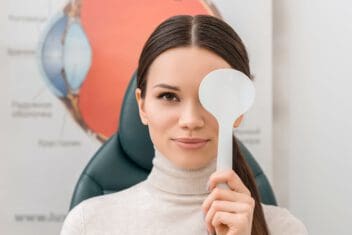How to Test for Your Dominant Eye (& Why It Matters)
Home / Vision Education Center /
Last Updated:
Just like having a dominant hand, it is possible to have a dominant eye. In most cases, people do not realize that one eye is dominant.
Table of Contents
You can determine a dominant with some testing. It is relatively simple to perform and does not cause any pain.
If you have a dominant eye, there are some possible implications. Sometimes, treatment is necessary to correct a dominant eye.
What Is a Dominant Eye?

Most people have a dominant hand they give preference to when performing a variety of tasks. A dominant eye is a similar concept.
When someone has a dominant eye, it gives a little more information to the brain’s visual center. This often means it provides information that is more accurate about an object’s location.
There are three primary types of eye dominance.
- Motor dominance: This type is characterized by the eye being less likely to lose its fixation close to the convergence near point.
- Sighting dominance: This type occurs when one eye is preferred when fixating on a target.
- Sensory dominance: This type is characterized by one of the eye’s vision being stronger than the other.
For most people, this is a normal visual condition. Their eyes are still essentially working as a team, and the visual acuity in both eyes is mostly equal. One eye is simply preferred, or it is the eye that leads.
It is estimated that left eye dominance is observed in about 57 percent of people who are left-handed and 35 percent of people who are right-handed.
There are cases where a dominant eye is present in dysfunctional cases of strabismus and amblyopia. Strabismus is characterized by the eyes not working together as a team, resulting in them not being able to maintain proper alignment. It can be intermittent or constant.
There are different types of strabismus.
- Exotropia: One eye goes outward.
- Esotropia: One eye goes inward.
- Hypotropia: One eye goes downward.
- Hypertropia: One eye goes upward.
Amblyopia is the medical term for a lazy eye. This condition results from the brain and eye not working as a team. The brain essentially favors one eye over the other.
Why Your Dominant Eye Matters?
When you have two healthy eyes, it may not matter which one is dominant. However, eye dominance can impact your vision health and performance in certain activities.
Using the dominant eye enables target shooters to accurately take aim before firing. If you play golf or baseball or are a photographer, you can use your stronger eye to focus better on a target.
You deserve clear vision. We can help.
With 135+ locations and over 2.5 million procedures performed, our board-certified eye surgeons deliver results you can trust. Your journey to better vision starts here.
To perform at you best in these or similar activities, you may want to know your dominant eye so you can make the most of it. You may require some vision correction to optimize performance if your dominant eye doesn’t correspond to your stronger hand.
People that are candidates for monovision also need their to determine their dominant. This therapy entails correction for near vision in one eye and distance vision in the other.
It’s the dominant eye that’s corrected for distance vision with this treatment.
Ophthalmologists will also perform eye dominance tests to diagnose and treat a lazy eye condition in children. To treat it and prevent permanent loss of vision in the weaker eye, the child’s dominant eye is patched.
Numerous other vision complications, including cataracts and crossed eyes in children, may warrant an eye dominance assessment.
Testing for a Dominate Eye

If you want to determine a dominant eye, you can use various techniques to get your answer. The Miles Test is a popular option, and it is simple to perform. The purpose is to evaluate vision quickness and sharpness.
This test uses the following steps:
- Face your palms away from your body and put your arms out in front of your body.
- Form a small hole with your hands, crossing the forefingers and thumbs.
- Look at something that is about 20 feet in the distance.
- Keep both eyes open and look at it via the hole made with your hands.
- Close one eye and then open it. This should show the object you’re focusing on either jumping to the side or disappearing from the hole you made with your hands.
- If the object does not jump when one eye is covered, this is your dominant eye.
The Point Test is another option. To perform this test, use the following steps:
- Pick a distance target, such as a vase or a hanging photo.
- Using both hands, point at it with your hands intertwined so that both index fingers are pointed at it.
- While fixating on it, alternate between closing one eye and then the other.
- The dominant eye is the one that remains lined up with the target.
For the Hole-in-Card Test, follow these procedures:
- Stand 6 meters from an object, holding card with a hole in the middle
- Holding the card with both hands and both eyes open, view the target through the hole
- Alternately close one eye and look through the hole with the other
- Without changing your initial eye/card alignment, move the card closer to your head/eyes
- The eye below the card hole is the dominant one
You may also try the Near Point Convergence Test as follows:
- Focus on a target moving toward your nose
- Your non-dominant eye will be the first to diverge to the temporal side of your face
What Are the Treatment Options?
A dominant eye typically does not require any treatment. If it is associated with amblyopia or strabismus, it’s usually necessary to treat these conditions.
Early treatment options for amblyopia generally consists of the following:
- Eyeglasses
- Vision therapy
- Eyedrops
- Eye patching
You may be prescribed one of these methods or a combination of them. Early intervention is imperative for the best outcome, but it is possible to see improvements in a lazy eye no matter how old you are when you start treatment.
To treat strabismus, eyeglasses can be beneficial for some people. If these are not effective, there are surgical procedures that may help to correct eye muscles that are unbalanced. Doctors might also blur or patch the strong eye to give the weaker eye a chance to catch up so they are even.
If you have a dominant eye that concerns you, work with an eye doctor to determine the best path forward. Together, you can come up with a treatment plan that fits your individual needs.
You deserve clear vision. We can help.
With 135+ locations and over 2.5 million procedures performed, our board-certified eye surgeons deliver results you can trust. Your journey to better vision starts here.
References
- Eye-Dominance, Writing Hand, and Throwing Hand. (April 1999). Laterality.
- Strabismus and Crossed Eyes. All About Vision.
- Amblyopia. National Eye Institute.
- Strabismus Treatment. (September 2012). American Academy of Ophthalmology.
- What Is Amblyopia or Lazy Eye? Optometrists Network.
- Eye Dominance. (June 15, 2021). American Academy of Ophthalmology.
- Quantifying Sensory Eye Dominance in the Normal Visual System: A New Technique and Insights into Variation across Traditional Tests. (December 2010). Investigative Ophthalmology & Visual Science.
This content is for informational purposes only. It may have been reviewed by a licensed physician, but is not intended to serve as a substitute for professional medical advice. Always consult your healthcare provider with any health concerns. For more, read our Privacy Policy and Editorial Policy.